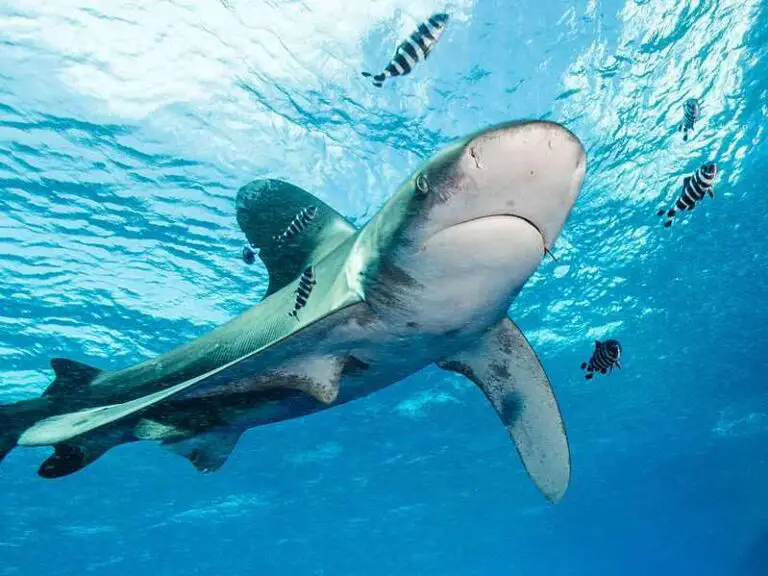5 Ocean Trophic Levels Explained
Ocean trophic levels are; primary producers (level one), primary consumers (level two), secondary consumers (level three), tertiary consumers (level four), and apex predators (level five).
This article discusses the trophic levels of the marine ecosystem, as follows;
1). Level One: Primary Producers (as one of the Ocean Trophic Levels)
The first trophic level in the ocean is occupied by primary producers.
These organisms are autotrophic, meaning that they can manufacture their own food using solar energy, through the process of photosynthesis.
Examples of primary producers in the ocean are; phytoplankton, algae, bacteria, and seaweed.
The most important primary producer in the ocean is phytoplankton, and this is due to the high mobility and geographic versatility of this organism, which allow its various species to occur in most oceans of the world [2].
Other primary producers like algae are also important, and contribute to the production and introduction of bioenergy into the marine ecosystem [1].
It must be noted that the food-manufacturing activities of primary producers marks the onset of nutrition in the energy pyramid of any biome.
The effectiveness of primary producers as an ultimate energy source is dependent on their population size. In most oceans, these organisms reproduce rapidly, and constitute a significant portion of the marine organic community.

2). Level Two: Primary Consumers
Types of consumers in the ocean are primary, secondary and tertiary consumers, which are distinguished from one another based on the ecologic scope of their diet.
Primary consumers are those whose nutrition depends solely on primary producers like plants, algae and phytoplankton.
Examples of primary consumers in the ocean are; sea urchins, manatees, mussels, sea turtles, parrot fish, and zooplankton that include fish larvae, jelly fish, krill, segmented worms, and copepods.
The feeding choices of primary consumers can be attributed to the fact that these organisms are non-autotrophic in nature, but lacking in physiologic attributes to prey on other autotrophs. Primary consumers constitute part of the diet of organisms in higher trophic levels in the ocean.
3). Level Three: Secondary Consumers (as one of the Ocean Trophic Levels)
Secondary consumers (or secondary predators) in the ocean are heterotrophic organisms that are slightly larger than primary consumers, and are therefore capable of preying upon this category.
In addition to preying on primary consumers, many of the secondary consumers can also prey on primary producers like plant, phytoplankton and algae. This gives them a much broader scope of nutritional selection.
Examples of secondary consumers are; clownfish, corals, herring, sardine, and lobster.
There is often a small degree of difficulty when trying to choose a distinct trophic level for any organism, such as that which could be encountered in the categorization of seals and squids, since these are large consumers but may still fall prey to other predators in the ocean.
As a result, it is common for the trophic classification of ocean organisms to be based on the specific organisms present in any given selection.
4). Level Four: Tertiary Consumers
In the ocean, tertiary consumers are heterotrophic organisms that are relatively large, and can feed on both primary and secondary consumers.
Examples of tertiary consumers in the ocean are; large fish like tuna, seals, turtles, dolphins, and moray eels.
In studies of ocean trophic levels where the Apex Predator category is not distinguished from tertiary consumers; these marine apex predators are listed among tertiary consumers.
However, distinguishing them into two different categories is helpful where there is need for a more detailed analysis.
5). Level Five: Apex Predators (as one of the Ocean Trophic Levels)
Apex predators are the largest consumers that occupy the topmost level of the food chain or energy pyramid in an ecosystem.
The largest ocean predator is the whale, which could be any of multiple species with slightly dissimilar physiological attributes.
Examples of apex predators in the ocean include Great White Shark, Sperm Whale, and Killer Whale.
It must be noted that in very complex ecological classification schemes, some of these organisms will be placed at a different trophic level from others. For example, sharks may be classified below whales in some schemes.

Conclusion
Ocean trophic levels are;
1. Level One: Primary Producers
2. Level Two: Primary Consumers
3. Level Three: Secondary Consumers
4. Level Four: Tertiary Consumers
5. Level Five: Apex Predators
References
1). Falkowski, P.; Knoll, A. H. (2007). "An Introduction to Primary Producers in the Sea: Who They Are, What They Do, and When They Evolved." Available at: https://doi.org/10.1016/B978-012370518-1/50002-3. (Accessed 17 February 2023).
2). Valiela, I. (2015). "Primary Producers in the Sea. In: Marine Ecological Processes." Springer, New York, NY. Available at: https://doi.org/10.1007/978-0-387-79070-1_1. (Accessed 17 February 2023).




